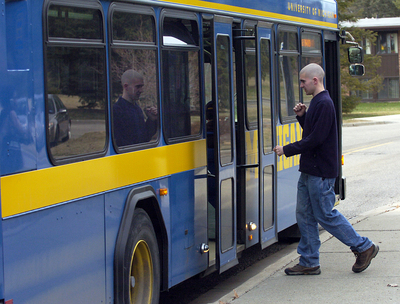University of Michigan sustainability initiative brings 3 more hybrid buses to campus
The University of Michigan added three new hybrid buses to its fleet this month, fulfilling a September 2011 commitment made by president Mary Sue Coleman that the university would introduce seven hybrid buses in a year in an effort to be more sustainable.

Now one in six U-M buses are hybrids.
AnnArbor.com file photo
The 40-foot hybrid-electric buses are reported to have better mileage, roughly getting five miles per gallon of diesel fuel, a 30 percent improvement when compared to the conventional U-M buses. U-M estimates the seven buses will bring a combined annual fuel savings of $44,000.
The buses use a roof-mounted battery system to supplement their diesel engines, allowing for reduced emissions. Using a generator, the bus can store energy released from stopping at a light or stop sign and use it when accelerating, further preserving fuel.
Each bus costs $518,345, according to U-M. The hybrids cost $175,000 more than conventional buses. So far U-M has spent $3.6 million on the hybrids, although their purchase partially has been subsidized by $700,000 in federal grant funds.
The buses are part of a $14 million sustainability initiative launched last September. which Coleman said will be accomplished by embracing solar panels, going trayless in certain cafeterias, reducing runoff, gathering food from local sources, applying less chemicals in grounds care, limiting emissions by 25 percent in the next 13 years and introducing the hybrids.

U-M President Mary Sue Coleman announced a $14 million sustainability initiative last September.
Angela Cesere | AnnArbor.com
"Right now hybrid technology is the most cost efficient, sustainable and efficient mode to go," said Keith Johnson, associate director of transportation operations.
Johnson said U-M is using the new hybrid buses to replace older models from the early 2000s.
Coleman said by 2025 she expects all university buses to by hybrids. Johnson said that over the next decade the university will acquire between two and four buses a year, either with hybrid technology or a similar system.
More than 40 city-owned hybrid buses already have been rolling around Ann Arbor since 2007. In their first two years, the Ann Arbor Transportation Authority's fleet of 20 hybrid buses conserved 100,000 gallons in fuel, for a monetary savings of $270,000.
In addition to the hybrids, the university already has 56 hybrid electric passenger vehicles and 15 all-electric vehicles.
According to university figures, ridership of U-M buses is increasing, rising from 6.5 million rides in fiscal 2010 to 6.9 million rides in fiscal 2011. Last year, usage increased to roughly 7.2 million rides, according to Johnson.
Kellie Woodhouse covers higher education for AnnArbor.com. Reach her at kelliewoodhouse@annarbor.com or 734-623-4602 and follow her on twitter.


Comments
andys
Wed, Sep 12, 2012 : 2:56 p.m.
We all leave our 3,500 sq ft homes, and drive to work in our SUV's, and then make public transit users ride on expensive hybrid buses, with limited gas savings, to make us all feel better about our personal non-sustainable life styles. Typical of the local latte liberals.
Justavoice
Wed, Sep 12, 2012 : 10:32 a.m.
While steps in the right direction are always helpful, what I find missing is as a world class University is missing the mark in sustainable power generation and lot electric charging. U of M has yet to launch any decent initiative for parking lot electric charging for public or staff use despite slowly increasing demand, and sustainable power generation is extremely low or next to not existent.
Matt A
Wed, Sep 12, 2012 : 2:56 p.m.
Regarding infrastructure for electric vehicles: how do you think the electricity is generated in this area that is needed to power electric vehicles? Primarily coal, one of the most polluting sources of energy known. Electric vehicles, at this point, are a complete environmental joke and I'm thrilled that the U hasn't made a greater investment in providing charging stations. You are simply trading one type of pollution for another. Go with the hybrid until 'cleaner' energy sources are used for electricity production in this area.
A2comments
Wed, Sep 12, 2012 : 10:29 a.m.
Where is the analysis of the environmental impact, I.e. less emissions per mile?
andys
Tue, Sep 11, 2012 : 9:16 p.m.
"Each bus costs $518,345, according to U-M." "The hybrids cost $175,000 more than conventional buses. " "U-M estimates the seven buses will bring a combined annual fuel savings of $44,000." 7 buses x $175,000 = $1,225,000 / $44,000 = 27.8 years to amortize the hybrid premium. Economically this makes little sense. Environmentally are we really doing any good, or is this feel good BS? (And yes I know that we go $700k in fed grant funds, but that did not fall from the sky, all of us taxpayers have to pay for that.)
andys
Wed, Sep 12, 2012 : 2:49 p.m.
Adam you are way off base. You need to pay better attention to details, especially before contradicting someone's analysis.
A2comments
Wed, Sep 12, 2012 : 10:28 a.m.
Agree. Adam's math is not correct. $44,000 savings in total, divided by 7 vehicles is the per vehicle savings per year. You divide that into $175,000. Without the grant this is a very bad investment.
Adam
Wed, Sep 12, 2012 : 2:57 a.m.
This isn't quite true. You're skewing this a bit by not taking into account that the time needed to break even runs in parallel per bus. Indeed, it will take a total of 27.8 bus-years, but only about 4 years per bus, and therefore (assuming all busses run simultaneously) it will only take 4 years to break even.: $175,000 / $44,000 = 3.98 years
Josh Jones
Tue, Sep 11, 2012 : 8:12 p.m.
There are currently 48 buses in the fleet, seven of those are hybrids. None of the conventional buses have been retired yet. This is not including all of the white hospital shuttle buses that run. There are eight 28 ft. shuttle buses and five 35ft transit buses operated around the Health System
kenUM
Wed, Sep 12, 2012 : 12:33 a.m.
The entire fleet consists of 61 buses, 2 Para-Transit buses, and 4 support non transit vehicles.
Dog Guy
Tue, Sep 11, 2012 : 8:11 p.m.
U of M drives a much better bargain than AATA for hybrid buses; perhaps AATA has a finder's fee built in. U of M's cost per passenger mile is a tiny fraction of that for AATA.. AATA should contract its operations out to U of M for about 37% cost savings.
braggslaw
Tue, Sep 11, 2012 : 7:21 p.m.
The hybridization of buses makes business sense... large mass, stop and go traffic etc. There is also the advantage of less wear and tear on the brake systems as electrical regeneration creates resistance via a magnetic field. no such business case exists for cars.